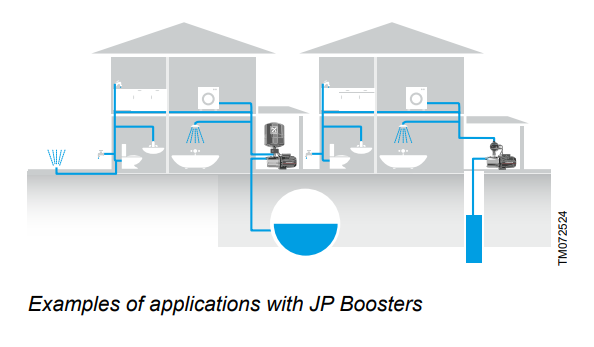Self-priming pumps are surface pumps, usually used to pump water from wells or as a part of domestic waterworks. Their advantage is easy operation and affordability.
Self-priming pumps are used primarily for pumping water from wells, but also as pressure boosting systems in the drinking water distribution. They are usually installed as part of a domestic waterworks, but are also suitable, for example, for a pool filtration system.
They belong to a specific category of surface centrifugal pumps. While with a conventional centrifugal pump you have to fill the entire pipeline with water before turning it on, the self-priming type has a greater suction capacity and can draw water automatically only with the need to fill the pump itself before first use.
Keep in mind that, by their physical nature, self-priming pumps are not suitable for pumping from a depth of more than 8 meters. Another possible disadvantage is the sensitivity to dry running, which can cause damage. Most pumps available on our site are therefore equipped with dry running protection, which disconnects the pump in the event of a lack of water and prevents damage.
Correctly used self-priming pumps are a reliable and affordable solution for a wide range of domestic and garden applications.

As in the case of other pumps, it is crucial to consider liquid capacity, to what elevation and from what distance it will pump:
We also recommend that you consider dry-running protection. For some products, there is even thermal protection to prevent the motor from overheating. With regard to the location of the pump, its material (for example, stainless steel) or the degree of protection also plays a role.
A stand-alone pump usually does not include a control system. When plugged in, it always runs at full capacity. For simple applications - such as watering or pool filtration - the pump can be used without further control.
For your own comfort, we recommend getting additional pressure or flow switch (PM1, PM2, HiControl, ...). The pump then switches on based on our water usage - for example by turning the tap. Such a solution is particularly suitable for irrigation, where there is a piece of pipe behind the pump and a control valve to which the hose is connected. It would be undesirable to pressurize the hose itself, as it would not be possible to entangle it.
For domestic water supply, it is suitable to supply the pump with a pressure switch and a pressure vessel, which will actually constitute a domestic waterworks.
Some of the self-priming pumps on our site are already equipped with a pressure switch and will start the pump automatically on demand. We also sell self-priming pumps with a frequency converter, which is able to regulate the flow depending on the required consumption.
They are usually connected directly to a standard 220V electrical socket.
Special attention must be paid to the material used for the suction pipe, which must not shrink during pumping. If you use a basic garden hose, the water station will create a vacuum during suction, which would deform and block your hose. Therefore, we recommend purchasing a suction hose, which is supplied with a suction basket as well.
No, there is no filtration. For purifying dirty water (such as with leaves or little stones), we recommend suction baskets, which are placed at the end of the suction hose directly into the well.
The possible location of additional filtration is debatable. This is because the filter on the suction side of the pump can cause such a loss of power that the pump may not have sufficient suction power for pumping. Simply put: when pumping from a depth of two meters, it is not a problem to place a filter in the well. If the depth is 7 meters, then the filter could act as a significant obstacle and pumping could not occur at all.
The location will always depend on the application. It is essential to protect the pump against freezing. At the same time, we recommend protecting it from rain, although pumps are usually protected against moisture.